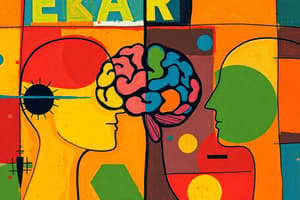Podcast
Questions and Answers
What is the term used to describe the application of regular grammar rules to irregular verbs and nouns during language development?
What is the term used to describe the application of regular grammar rules to irregular verbs and nouns during language development?
- Overextension
- Telegraphic speech
- Overregulation (correct)
- Displacement
At what stage do children typically realize that words can have more than one meaning?
At what stage do children typically realize that words can have more than one meaning?
- 36 months
- 30 months
- 7-9 years (correct)
- 18-20 months
Which concept in language development involves the capacity to communicate in another time or place?
Which concept in language development involves the capacity to communicate in another time or place?
- Infinite creativity
- Displacement (correct)
- Overextension
- Holophrase
According to the Nativist Approach, what causes children to attend to and perceive language in certain ways?
According to the Nativist Approach, what causes children to attend to and perceive language in certain ways?
What term describes the theory that language acquisition involves the interaction of environmental influences and an inborn tendency to acquire language?
What term describes the theory that language acquisition involves the interaction of environmental influences and an inborn tendency to acquire language?
What vocalization stage involves crying, cooing, and babbling, leading up to the child's first spoken word around 1 year old?
What vocalization stage involves crying, cooing, and babbling, leading up to the child's first spoken word around 1 year old?
What term describes the tendency to think of an object only in terms of its familiar function?
What term describes the tendency to think of an object only in terms of its familiar function?
Which heuristic involves estimating probabilities based on examples of relevant events, often disregarding scientific data?
Which heuristic involves estimating probabilities based on examples of relevant events, often disregarding scientific data?
What term defines the context of information influencing decision-making?
What term defines the context of information influencing decision-making?
In the context of language, what sets humans apart from other species?
In the context of language, what sets humans apart from other species?
What term refers to the smallest unit of meaning in language?
What term refers to the smallest unit of meaning in language?
Which aspect of language focuses on the characteristics of spoken language such as intonation and gesture?
Which aspect of language focuses on the characteristics of spoken language such as intonation and gesture?
What aspect of emotional intelligence involves being aware of and managing one's own emotions, self-motivation, empathy, and handling relations?
What aspect of emotional intelligence involves being aware of and managing one's own emotions, self-motivation, empathy, and handling relations?
What is the basis for academic achievements according to the text?
What is the basis for academic achievements according to the text?
What aspect is NOT a factor that affects intellectual functioning?
What aspect is NOT a factor that affects intellectual functioning?
What is a key characteristic of creative people according to the text?
What is a key characteristic of creative people according to the text?
Which theory of intelligence suggests that intelligence consists of a general factor (G factor) and specific abilities (S factor)?
Which theory of intelligence suggests that intelligence consists of a general factor (G factor) and specific abilities (S factor)?
Which type of twins show the strongest correlation in IQ scores according to the text?
Which type of twins show the strongest correlation in IQ scores according to the text?
Which type of thinking freely assesses elements of a problem and is best used in measuring creativity?
Which type of thinking freely assesses elements of a problem and is best used in measuring creativity?
Which theory of intelligence includes spatial, bodily, and linguistic intelligences among its categories?
Which theory of intelligence includes spatial, bodily, and linguistic intelligences among its categories?
What is the approximate heritability range mentioned in the text?
What is the approximate heritability range mentioned in the text?
Which factor is related to IQ similarities according to the text?
Which factor is related to IQ similarities according to the text?
What is the unusual combination seen in individuals with Savant Syndrome?
What is the unusual combination seen in individuals with Savant Syndrome?
Which scale is specifically mentioned for measuring intelligence in individuals aged 16 and older?
Which scale is specifically mentioned for measuring intelligence in individuals aged 16 and older?
What does the Wechsler Scale provide separate scores for in intelligence testing?
What does the Wechsler Scale provide separate scores for in intelligence testing?
Which of the following is NOT one of Thurstone's primary mental abilities?
Which of the following is NOT one of Thurstone's primary mental abilities?
In adoption studies, what relation is stronger according to the text?
In adoption studies, what relation is stronger according to the text?
According to Robert Sternberg's Triarchic Theory of Intelligence, what ability is related to coping with novel situations and generating multiple solutions?
According to Robert Sternberg's Triarchic Theory of Intelligence, what ability is related to coping with novel situations and generating multiple solutions?
Flashcards are hidden until you start studying
Study Notes
Intelligence and Creativity
- European-American children tend to outperform African-American children on intelligence tests.
- Emotional Intelligence (EQ) involves applying knowledge about emotions to life, including managing one's own emotions, self-motivation, empathy, and handling relationships.
Emotional Intelligence
- Intra/interpersonal skills: empathy, self-insight, and self-control.
- Coping with stress, depression, and aggressive behavior.
- Awareness of emotions and their appropriateness in different situations.
Creativity
- Creative people produce original, appropriate, and valuable ideas and solutions.
- Characteristics of creative people: doing novel and useful things, taking risks, defying limits, and appreciating art and music.
- Divergent thinking: freely associating elements of a problem to generate many ideas.
Measurement of Intelligence
- Wechsler Scale: used for individuals 16 and older.
- Deviation score: separates subscales (verbal and performance tasks) into three IQ scores: verbal IQ, performance IQ, and functional IQ.
Heuristics in Decision Making
- Representative heuristic: judging events based on their similarity to a typical case.
- Availability heuristic: estimating probability based on the availability of relevant information.
- Anchoring and adjustment heuristic: using an initial estimate as an anchor and adjusting it based on new information.
- Framing effect: the context of information presentation affects decision-making.
Language
- Non-human communication capability: a unique aspect of humans.
- Language: a system of socially shared, arbitrary symbols (sounds, signs, and words) arranged according to rules of grammar.
Psycholinguistics
- Language acquisition: how language is acquired, produced, and used.
- Phonemes: the smallest unit of sound in spoken language.
- Morphemes: the smallest unit of meaning.
- Syntax: specific rules for arranging and combining words to form sentences.
- Semantics: meaning derived from morphemes, words, and sentences.
- Pragmatics: the characteristics of spoken language, including intonation, gesture, and indicating social meaning.
Language Development
- Telegraphic speech: children understanding syntax (around 30 months).
- Overextension/underextension: applying words to a broader range of objects than intended (around 18-20 months).
- Overregulation: applying grammatical rules to irregular verbs/nouns (around 36 months).
Nature vs. Nurture
- Learning theory: imitation and reinforcement, with parents as role models.
- Nativist approach: innate factors cause children to attend to and perceive language in certain ways.
Language Acquisition Device (LAD)
- Represents the inborn tendency to learn language.
- Prepares the nervous system to learn universal grammar.
Language and Culture
- Linguistic-relativity hypothesis: language structure influences thought and perception.
- Bilingualism: metalinguistic skill, learning culture in depth, and speaking two or more languages.
Language Development
- Prelinguistic vocalizations: crying, cooing, and babbling.
- Holophrase: a single word with complex meaning (around 2 years old).
- First spoken word: around 1 year old.
Intelligence and Cognitive Development
- Full-scale IQ: measures intellectual functioning.
- Socioeconomic and ethnic differences: considering social class and ethnicity in IQ scores.
- Gender differences: no overall differences in cognitive ability, but differences in verbal and visual-spatial abilities.
Genetic Influences
- Kinship studies: identical twins (MZ) show more similar IQ scores.
- Twin studies: moderate relationship between IQ scores of fraternal twins, siblings, and parent-child pairs.
- Adoption studies: stronger relationship between IQ scores of adopted children and biological parents.
Heritability
- 40% to 60% of the difference between an individual's IQ score and others can be explained by heredity.
Factors Affecting Intellectual Functioning
- Genetic factors
- Stimulating environment (home and school)
- Health
- Socioeconomic status
Studying That Suits You
Use AI to generate personalized quizzes and flashcards to suit your learning preferences.




